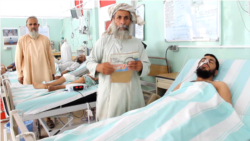Taliban fighters in northern Afghanistan have reached the borders of Central Asia and there is a familiar sense of urgency in the three countries in the region with an Afghan frontier: Tajikistan, Turkmenistan, and Uzbekistan.
Familiar because the Taliban have occupied many of the northern Afghan districts bordering Central Asia before, more than 20 years ago, and much of the response seen in the Tajik, Turkmen, and Uzbek capitals resembles the moves they made in the late 1990s.
And yet, much has changed since then also.
Refugees
On July 7, the independent Tajik news agency Asia-Plus reported more than 1,000 Afghan refugees had crossed into Tajikistan’s eastern Gorno-Badakhshan region, fleeing the fighting between advancing Taliban forces and government troops in Afghanistan’s neighboring Badakhshan Province.
Barely two weeks earlier, Yodgor Fayzov, the head of that sprawling Tajik region, ordered local officials to prepare for the arrival of up to 10,000 refugees, though he warned that number could climb to as high as 30,000.
This is neither surprising nor an exaggerated figure.
In late September 1996, the Taliban captured Kabul and continued its drive northward.
On April 26, 1997, Tajik President Emomali Rahmon (then called Rakhmonov) was hosting the head of Russia’s Federal Border Service, Andrei Nikolaev, and Rahmon said some 100,000 displaced people had fled to the border of Tajikistan.
The Tajik Civil War, which started in 1992, was coming to an end and on June 27, 1997, the government and its battlefield opponents signed a peace agreement.
The appearance of the Taliban in Afghanistan played a role in hastening the two sides -- pushed by mediators from Russia, Iran, and the UN -- to end the war.
More than 50,000 Tajik citizens, at least, had fled the fighting and crossed into Afghanistan during those five years. Among those 100,000 refugees Rahmon mentioned were several thousand citizens of his country.
The Tajik government needed the full force of its military for the battles inside Tajikistan at that time.
Russian border guards -- with some help from a Commonwealth of Independent States (CIS) peacekeeping force that included troops from Kazakhstan, Kyrgyzstan, and Uzbekistan -- were tasked with defending the Afghan border.
As peace took root, Tajik troops were gradually deployed to the Afghan border, joining the Russian border guards who ended up staying there until 2005.
In late September 2000, Tajik Security Council Secretary Amirkul Azimov warned there were again some 100,000 Afghan refugees massing along the border with Tajikistan attempting to escape the fighting.
Rahmon said Tajikistan would not accept any Afghan refugees and, until those 1,000 Afghan refugees crossed into Tajikistan on July 4-5, 2021, none ever did.
Afghan refugees had also crossed into Turkmenistan and Uzbekistan in the 1990s.
Some 800 crossed into Turkmenistan in November 1996, and about 8,000 in June 1997, all of whom Turkmen authorities sent back after a few days.
WATCH: Taliban Seizes Civilian Homes In Kandahar As Government Forces Fight To Defend City
Most were from Afghanistan’s Badghis Province, where on July 7, 2021, reports said the Taliban had captured all the province’s districts and a fierce battle for control of the provincial capital, Qala-e Naw, was being fought.
There were already an estimated 5,000 to 8,000 Afghan refugees in Uzbekistan by 1994, but Uzbek authorities gradually sealed off the country’s relatively short 160-kilometer border with Afghanistan.
When the Taliban first approached the Uzbek border in 1997 and in August 1998 when they seized areas that border Uzbekistan, Uzbek officials did not allow Afghan refugees to cross.
So far, the only Afghan civilian refugees reported to have crossed into Central Asia are those in eastern Tajikistan.
For now, displaced Afghans in the north are gathering in Tajik camps not far from the areas they abandoned to escape the fighting.
But the camps are short of food, water, and medical care, and many people often have to live together in cramped rooms and tents. If this dire situation continues, it is only a matter of time before some try to cross northern borders, looking for better temporary conditions in neighboring countries.
Soldiers And Paramilitaries
Unlike the late 1990s, this time the Tajik and Uzbek governments are contending with the Afghan government troops trying to flee the fighting in Afghanistan.
On June 21, when Taliban forces took the border post at Shir Khan Bandar, 134 Afghan soldiers fled into Tajikistan.
By July 5, Tajik authorities said 1,037 Afghan soldiers in total had crossed into Tajikistan and were being allowed to stay “for humanitarian reasons," but on July 7 Afghanistan’s National Security Council said some 2,300 Afghan soldiers had been sent from Tajikistan back to Afghanistan, many via plane to Kabul.
On June 23, Uzbek troops stopped 53 Afghan soldiers and members of paramilitary forces who attempted to cross into Uzbekistan and sent them back.
On June 26, three Afghan soldiers tried to cross into Uzbekistan, and the next day 44 others showed up at the border.
All were sent back to Afghanistan.
WATCH: 'They Would Cut Us Into Pieces': Afghan Civilians Flee Taliban Attacks In Kunduz
The Tajik and Uzbek governments did not have such a problem 20 years ago because the Afghan government they recognized was that of President Burhanuddin Rabbani and the only “government” forces were the fighters under the command of Rabbani’s defense minister, Ahmad Shah Masud.
They controlled only limited areas in northeastern Afghanistan along Tajikistan’s border and Masud’s stronghold in the Panjshir Valley. Tajikistan did allow Masud to evacuate several warplanes to Kulob and Masud and Rabbani were frequent visitors to Tajikistan.
Uzbekistan’s government supported ethnic Uzbek Afghan field commander Abdul Rashid Dostum, and while he fled through Uzbekistan in August 1998 when the Taliban defeated his forces, Dostum’s forces stayed in northern Afghanistan to wage a guerrilla campaign.
Taliban Ties
In the late 1990s, the Tajik and Uzbek governments were openly hostile toward the Taliban, while Turkmenistan, guided by economic interests in exporting its natural gas and brandishing its policy of neutrality, engaged with the Taliban, even allowing the group to open a representative office in Ashgabat.
Turkmenistan still touts its policy of neutrality, but something has clearly changed.
Turkmenistan’s first president, Saparmurat Niyazov, was able to deal with the Taliban and the Afghan group was undoubtedly pleased to have one Central Asian neighbor staying out of Afghan internal politics.
Niyazov’s successor as president, Gurbanguly Berdymukhammedov, who was practicing dentistry when the Taliban were neighbors in the late 1990s, seems less successful in relations with the Taliban.
Three Turkmen border guards and three Turkmen soldiers were killed in separate incidents along the Afghan border in February and May 2014, and it appeared the Taliban were behind those attacks, though the Turkmen government never admitted they occurred.
There has been information since then about other Turkmen soldiers and border guards being killed along the Afghan border.
Turkmen authorities have not commented about those reports.
But after the 2014 incidents, the Turkmen government started paying more attention to the country’s armed forces and purchasing weapons from several countries.
Turkmen authorities called up reservists in January 2019 to fortify positions along the Afghan border, and at the start of July 2021, Berdymukhammedov reportedly ordered more forces sent to the border area, including warplanes, tanks, and artillery, though officials later denied moving tanks and cannons to the border.
It seems clear Berdymukhammedov’s government is not as confident in benign relations with the Taliban as Niyazov’s government was, though a Taliban delegation did visit Ashgabat in February 2021 and again on July 11.
Tajik authorities have been quiet as the Taliban captured territory that took it up to their border. Tajik officials do not speak much about the Taliban.
But Tajik authorities have not invited Taliban representatives to visit, nor sent any officials to third countries to meet with Taliban representatives.
Uzbekistan probably currently has the best ties with the Taliban.
Uzbekistan hosted a Taliban delegation that visited for several days in August 2019.
Foreign Minister Abdulaziz Kamilov has met with Taliban representatives in several countries over the course of the last few years and it was Kamilov who was meeting with Taliban representatives in Pakistan in 2000 and 2001.
After Dostum fled in 1998, Uzbek authorities gradually and grudgingly came to accept the fact that the Taliban was its neighbor.
In October 2000, President Islam Karimov said “Tashkent is ready to recognize any government in Afghanistan, even if it is the Taliban government. It doesn't matter whether we like that government or not.”
The Uzbek government’s primary concern was the presence of militants from a homegrown group called the Islamic Movement of Uzbekistan (IMU) who had found refuge in northern Afghanistan and from which they crossed through the mountains into southern Kyrgyzstan in the summer of 1999 and again in the summer of 2000 when they also went to eastern Uzbekistan.
It is groups such as the IMU that the Central Asian governments fear, far more than an unlikely attack from the Taliban.
There are now several militant groups in northern Afghanistan with citizens of Central Asia in their ranks.
Back To The First Plan
Following the recent Taliban advances, Uzbekistan conducted tactical military exercises near the Afghan border in late June. On July 7, Uzbek troops conducted joint exercises with Russian troops in Uzbekistan’s Samarkand Province and Tashkent is sending additional forces to the Afghan border.
In October 1996, Uzbekistan moved elite forces to the Afghan border and sent more troops in August 1998 after the Taliban captured Mazar-e Sharif.
Some 23 years later, Tajikistan on June 26 put its forces near the Afghan border on heightened alert and on July 5 the Tajik government called up some 20,000 reservists to strengthen forces along the approximately 1,360-kilometer frontier with Afghanistan.
Elements of Russia’s 201st Division, which is stationed in Tajikistan, conducted military exercises on July 6 involving attack helicopters and tanks, specifically in response to the rapidly deteriorating situation in Afghanistan.
Also on July 6, representatives of the Russian-led Collective Security Treaty Organization (CSTO) visited the Tajik-Afghan border area.
The following day, Russian Foreign Minister Sergei Lavrov said the Russian troops based in Tajikistan and the CSTO would “prevent any aggressive encroachments against our allies."
In February 1997, Russian Defense Minister Igor Rodionov met with his Central Asian counterparts (except the Turkmen defense minister) in Tashkent and said the Russian government was prepared to step in to protect the southern borders of the CIS.
Over the next few years, Russian troops regularly conducted joint military exercises with all the Central Asian countries except Turkmenistan in Russia and Central Asia.
It seems all of the parties near Afghanistan's northern borders are well aware of the events that occurred in the late 1990s and 2000s in the war-torn country and are carefully preparing for a possible return to power of the Taliban and all of the possible ramifications.













